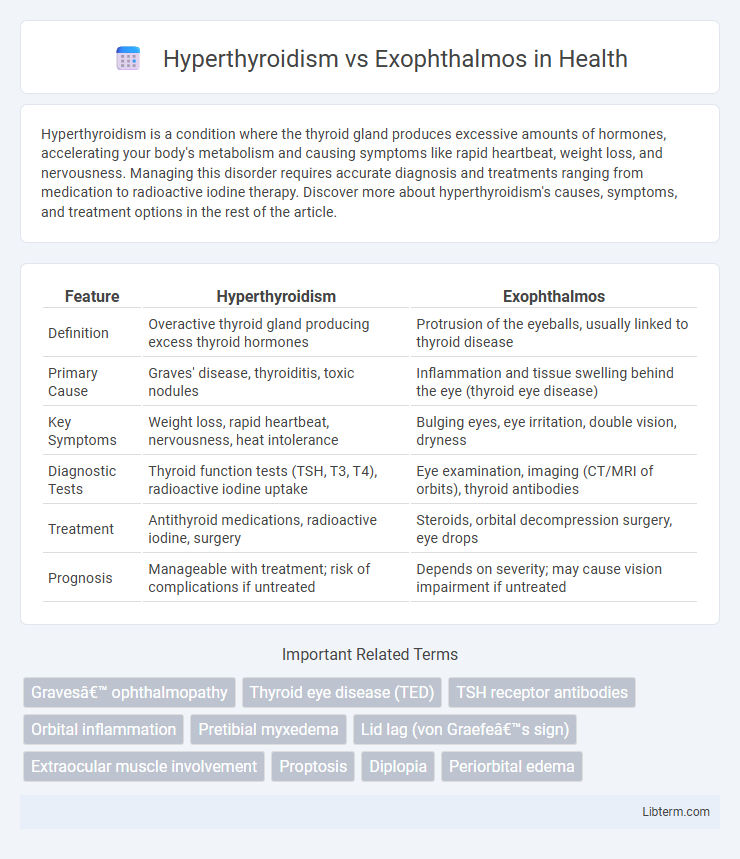Hyperthyroidism is a condition where the thyroid gland produces excessive amounts of hormones, accelerating your body's metabolism and causing symptoms like rapid heartbeat, weight loss, and nervousness. Managing this disorder requires accurate diagnosis and treatments ranging from medication to radioactive iodine therapy. Discover more about hyperthyroidism's causes, symptoms, and treatment options in the rest of the article.
Table of Comparison
| Feature | Hyperthyroidism | Exophthalmos |
|---|---|---|
| Definition | Overactive thyroid gland producing excess thyroid hormones | Protrusion of the eyeballs, usually linked to thyroid disease |
| Primary Cause | Graves' disease, thyroiditis, toxic nodules | Inflammation and tissue swelling behind the eye (thyroid eye disease) |
| Key Symptoms | Weight loss, rapid heartbeat, nervousness, heat intolerance | Bulging eyes, eye irritation, double vision, dryness |
| Diagnostic Tests | Thyroid function tests (TSH, T3, T4), radioactive iodine uptake | Eye examination, imaging (CT/MRI of orbits), thyroid antibodies |
| Treatment | Antithyroid medications, radioactive iodine, surgery | Steroids, orbital decompression surgery, eye drops |
| Prognosis | Manageable with treatment; risk of complications if untreated | Depends on severity; may cause vision impairment if untreated |
Understanding Hyperthyroidism and Exophthalmos
Hyperthyroidism is a condition characterized by excessive thyroid hormone production, leading to symptoms like weight loss, rapid heartbeat, and nervousness. Exophthalmos, often associated with Graves' disease--a common cause of hyperthyroidism--manifests as the abnormal protrusion of the eyes due to inflammation and tissue swelling behind the eyeball. Understanding the link between hyperthyroidism and exophthalmos is crucial for accurate diagnosis and effective treatment, as controlling thyroid hormone levels can significantly reduce eye-related symptoms.
Causes of Hyperthyroidism
Hyperthyroidism primarily results from autoimmune disorders such as Graves' disease, which stimulates excessive thyroid hormone production, leading to systemic symptoms and often causing exophthalmos due to inflammation and swelling of eye tissues. Other causes include toxic multinodular goiter and thyroiditis, which increase hormone output independently of pituitary regulation. Understanding these etiologies is critical for diagnosing and managing hyperthyroidism and its ophthalmic complications.
What is Exophthalmos?
Exophthalmos is a medical condition characterized by the abnormal protrusion or bulging of one or both eyeballs, often associated with hyperthyroidism, particularly Graves' disease. This eye symptom occurs due to inflammation and swelling of the eye muscles and fatty tissues behind the eyeball, leading to an enlarged and pushed-forward appearance. Hyperthyroidism causes the overproduction of thyroid hormones, which can trigger autoimmune responses that result in the development of exophthalmos.
Key Differences Between Hyperthyroidism and Exophthalmos
Hyperthyroidism is a systemic endocrine disorder characterized by excessive thyroid hormone production, while exophthalmos specifically refers to the abnormal protrusion of the eyeballs, commonly seen as a symptom rather than a standalone condition. Key differences include hyperthyroidism causing metabolic abnormalities such as weight loss, heat intolerance, and palpitations, whereas exophthalmos primarily presents with ocular signs like eye bulging, dryness, and double vision. Hyperthyroidism can lead to exophthalmos, especially in Graves' disease, but exophthalmos does not occur in all hyperthyroid cases.
How Hyperthyroidism Leads to Exophthalmos
Hyperthyroidism causes an overproduction of thyroid hormones that triggers immune system activation and inflammation behind the eyes, leading to swelling and tissue expansion. This immune response results in the characteristic outward bulging of the eyes known as exophthalmos, commonly seen in Graves' disease. Elevated thyroid hormone levels increase the fibroblast activity and accumulation of glycosaminoglycans in orbital tissues, directly contributing to the protrusion of the eyeball.
Signs and Symptoms: Comparing the Two Conditions
Hyperthyroidism presents with signs such as rapid heartbeat, weight loss, heat intolerance, and tremors, while exophthalmos is characterized by the abnormal protrusion of the eyeballs, often accompanied by eye irritation, dryness, and double vision. Both conditions can share symptoms like eye discomfort and light sensitivity, but exophthalmos specifically involves visible bulging eyes due to inflammation and swelling behind the orbit. Recognizing these distinguishing symptoms aids in accurate diagnosis, as hyperthyroidism affects metabolic functions broadly whereas exophthalmos primarily impacts ocular appearance and function.
Diagnostic Methods for Hyperthyroidism and Exophthalmos
Hyperthyroidism is diagnosed through blood tests measuring elevated thyroid hormones such as free T4 and suppressed thyroid-stimulating hormone (TSH) levels, alongside radioactive iodine uptake scans to assess thyroid function. Exophthalmos, often linked with Graves' disease, is evaluated clinically by measuring the degree of eye protrusion using a Hertel exophthalmometer and confirmed with orbital imaging techniques like CT or MRI to detect inflammation or tissue expansion. Combining biochemical assays with imaging studies enhances diagnostic accuracy for distinguishing hyperthyroidism-related exophthalmos from other orbital pathologies.
Treatment Options for Each Condition
Hyperthyroidism treatment primarily involves antithyroid medications like methimazole or propylthiouracil, radioactive iodine therapy, and sometimes thyroidectomy to regulate excessive thyroid hormone production. Exophthalmos, often linked to Graves' disease, requires management of inflammation and orbital pressure using corticosteroids, orbital decompression surgery, or radiation therapy to prevent vision loss and reduce eye protrusion. Each condition demands targeted therapeutic strategies to address hormone imbalance in hyperthyroidism and ocular complications in exophthalmos for optimal patient outcomes.
Managing Complications and Preventing Progression
Managing complications of hyperthyroidism and exophthalmos involves controlling thyroid hormone levels through antithyroid medications, radioactive iodine therapy, or thyroidectomy to prevent worsening symptoms and orbital damage. Regular ophthalmologic evaluations, corticosteroids, and orbital decompression surgery help reduce inflammation and protect vision in exophthalmos patients. Preventing progression relies on early diagnosis, smoking cessation, and close monitoring of thyroid function and eye involvement to minimize long-term complications.
Prognosis and Long-Term Outlook
Hyperthyroidism often leads to an improved prognosis with timely treatment through antithyroid medications, radioactive iodine, or surgery, resulting in normalized thyroid function and symptom relief. Exophthalmos, a common manifestation of Graves' disease associated with hyperthyroidism, may persist or worsen despite thyroid normalization, necessitating specialized ophthalmologic interventions to prevent vision impairment. Long-term outlook depends on early diagnosis and integrated management, as untreated hyperthyroidism increases risks of cardiovascular complications, while severe exophthalmos can lead to chronic eye surface damage and optic neuropathy.
Hyperthyroidism Infographic

 libterm.com
libterm.com